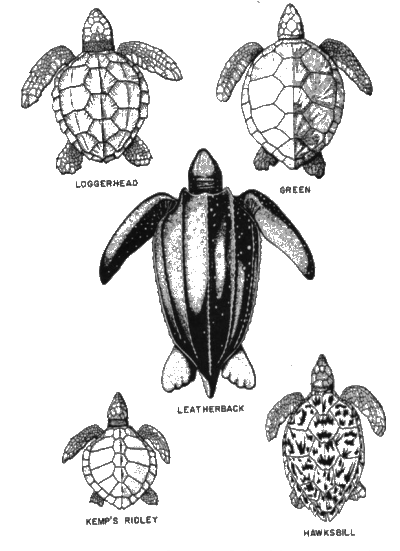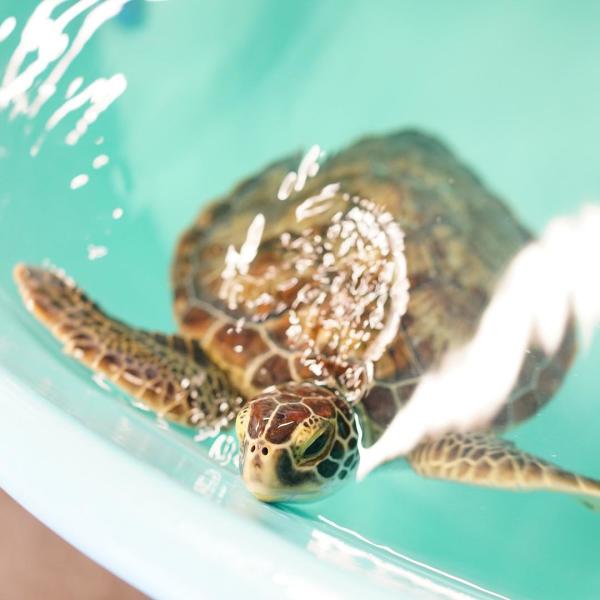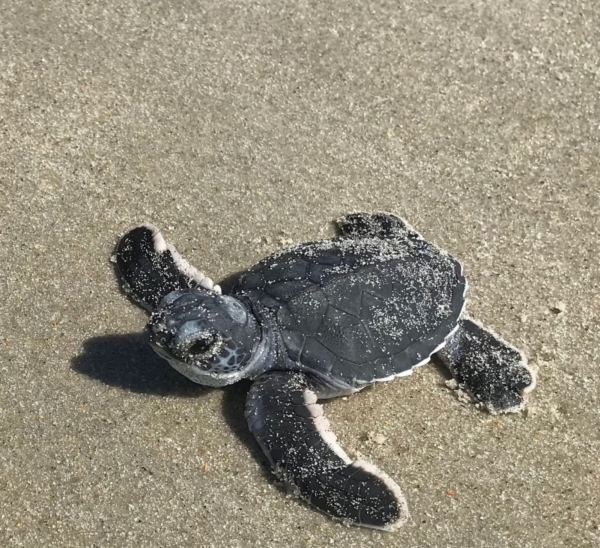The Network for Endangered Sea Turtles, or N.E.S.T., was founded in 1995 by Millie Overman. It is an all-volunteer 501(c)(3) non-profit organization dedicated to the protection and preservation of habitat and migration routes for threatened and endangered sea turtles on the Outer Banks and located at the North Carolina Aquarium on Roanoke Island.
There are 5 different species of sea turtles who visit and/or nest on the Outer Banks. They include the Loggerhead, Green, Leatherback, Kemp’s Ridley, and Hawksbill sea turtles. Our most frequent nesting turtles are Loggerheads, accounting for over half of our nests each season. We may use several different ways to determine what specific species the sea turtle may be. We can look at size, coloration, and also their scutes and scales. The sea turtle's carapace and plastron, or top and bottom portion of their shells, are made up of many different scutes. A scute is a bony plate that is part of a turtle's shell.

1. Loggerhead
An adult Loggerhead sea turtle weighs 250 – 400 pounds and can be up to 3.5 feet in length. Its carapace is reddish-brown while its skin tends to be a lighter tan or blonde color. A Loggerhead will have 5 lateral scutes.
2. Green
An adult Green sea turtle weighs 250-450 pounds and can be up to 5 feet in length. Its carapace can be a range of colors from light brown to dark green or brown with beautiful brightly colored stripes and patterns. Its skin tends to take on a greenish hue, because Green sea turtles are herbivores! Green sea turtles will have 4 lateral scutes.
3. Kemp's Ridley
An adult Kemp’s Ridley sea turtle weighs less than 100 pounds and will only be 2-3 feet in length. Its carapace is gray while the plastron is a lighter tan or yellow color, and it is very rounded. A Kemps Ridley will have 5 lateral scutes. Kemps Ridley sea turtles are listed as “critically endangered”.
4. Hawksbill
An adult Hawksbill sea turtle typically weighs about 150 pounds and are 2.5-3 feet in length. Its carapace is oval-shaped and brown in color with bright yellow, orange, or reddish stripes and designs. Hawksbill sea turtles have 4 lateral scutes that overlap each other. They also have a very pointed beak, just like a hawk.
5. Leatherback
An adult Leatherback sea turtle typically weighs 650-1,100 pounds and can be 5-9 feet in length. Its carapace is dark gray or black and does not have scutes. Leatherbacks are the only sea turtle without a hard shell. Instead, they have very thick and leathery skin with long ridges. The largest documented Leatherback was over 2,000 pounds. Just picture a VW bug sitting on the beach. Now that’s a big sea turtle!

N.E.S.T. takes on many roles to help protect these threatened and endangered sea turtles. From May until September, we have a team of ATV riders on the beach each morning looking for nests. These riders cover approximately 60 miles of beach from the Virginia-North Carolina border, to south Nags Head. If a nest is found, the ATV rider then makes a few calls and soon, a nesting response team is on the scene. The nest responders will identify the type of sea turtle that nested, locate the nest, collect an egg for DNA sampling, and mark off the nest for protection. In about 50-80 days, a team of folks called nest sitters will sit on the beach each night and eagerly await the arrival of sea turtle hatchlings. Each nest can have 80-120 eggs, though some have more or less. That may sound like a lot, but scientists estimate that only 1 hatchling in 1,000 will make it to maturity. For a Loggerhead, maturity is about 30 years old. That’s a long time! Once a nest hatches, it is our job to keep the hatchlings safe in the most natural way possible, as they make their journey from the nest to the ocean. A few days after the nest hatches, we will then excavate the nest. This gives us a chance to count hatched and unhatched eggs, release any live hatchlings that still remain, and gather lots of other important data.

N.E.S.T. also helps sea turtles who are sick or injured. We have a team of volunteers who help care for the sea turtles in the Sea Turtle Assistance and Rehabilitation Center, or STAR Center, at the North Carolina Aquarium on Roanoke Island. There are a number of sea turtles in the STAR Center at any given time. Their injuries may include boat strikes, entanglements, shark bites, fish hook catches, cold stunning, and more. What is “cold stunning”? In the winter months, sea turtles typically migrate to warmer waters. Unfortunately, some turtles stay a bit too long and become “cold-stunned”, or hypothermic. N.E.S.T. has a team of volunteers who search for these cold-stunned turtles. They then transport them to the STAR Center for treatment and rehabilitation. In addition to cold-stunned turtles, we also transport sea turtles suffering from other injuries. We also document turtles who are found deceased, and assist with necropsies for these turtles when necessary.
What should you do if you see a sea turtle on the beach? Whether it’s sick, injured, or nesting, it’s important not to touch or disturb the turtle! Sea Turtles do not come onto the beach unless they are nesting or something is wrong. Please just give us a call so we can have a team come immediately to assist the turtle. Our hotline number is 252-441-8622. Why not go ahead and program that into your phone right now? You never know when you might come across one of these beautiful creatures!
Sea Turtle FAQ
What time of year do sea turtles hatch in North Carolina?
Sea turtles begin their journey to shore to lay their eggs starting in May. Eggs take approximately 50-80 days to hatch, making July-October some of the best times to witness sea turtle hatchings.
What to do if you find a baby sea turtle on the beach?
Whether it’s sick, injured, or nesting, it’s important not to touch or disturb the turtle. Sea turtles do not come onto the beach unless they are nesting or something is wrong. Please just give N.E.S.T. (Network for Endangered Sea Turtles) a call so they can have a team come immediately to assist the turtle. Their hotline number is 252-441-8622.
https://www.nestonline.org/What sea turtles nest in North Carolina?
There are 5 different species of turtles that visit and nest along the shores of the OBX of North Carolina. They are Loggerhead, Green, Leatherback, Kemp’s Ridley, and Hawksbill sea turtles.
Where can I see sea turtles in OBX?
View sea turtles and learn about sea turtle conservation in the Sea Turtle Assistance and Rehabilitation (STAR) Center and interactive Sea Turtle Rescue exhibit at the NC Aquarium on Roanoke Island.
During nesting season, sea turtle nests can be found along the shore marked by signage and roped off to protect the eggs.
https://www.outerbanks.org/listing/north-carolina-aquarium-on-roanoke-island/290/
